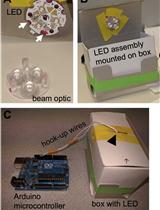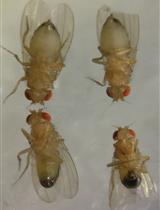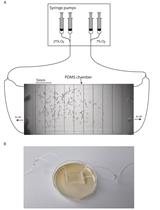- EN - English
- CN - 中文
Evaluation of Burkholderia cepacia Complex Bacteria Pathogenicity Using Caenorhabditis elegans
利用秀丽隐杆线虫评估洋葱伯克霍尔德菌复合体的致病性
发布: 2016年10月20日第6卷第20期 DOI: 10.21769/BioProtoc.1964 浏览次数: 7671
评审: Peichuan ZhangAnonymous reviewer(s)
Abstract
This protocol describes two biological assays to evaluate pathogenicity of Burkholderia cepacia complex (Bcc) strains against the nematode Caenorhabditis elegans. Specifically, these two assays allow one to identify if the under-investigated Bcc strains are able to kill the nematodes by intestinal colonization (slow killing assay, SKA) or by toxins production (fast killing assay, FKA). The principal differences between the two assays rely on the different killing kinetics for worms.
Keywords: Burkholderia cepacia complex strains (洋葱伯克氏菌菌株)Background
The Burkholderia cepacia complex (Bcc) occupies a critical position among Gram-negative multi-drug resistant bacteria. It consists of at least 20 closely related species. Many Bcc strains are multi drug and pandrug-resistant opportunistic human pathogens caused problematic lung infections in immune-compromised individuals, including cystic fibrosis (CF) patients. The use of non-vertebrate host model can be useful for dissecting virulence and pathogenicity determinants as well as identifying novel therapeutic targets (Kothe et al., 2003).
There are a good number of assays for detecting Bcc virulence against a large panel of host models, in liquid or in solid surface. However, some of those are mostly focused on phenotypic observations, which are difficult to detect and have a low reproducibility (Cardona et al., 2005). Herein, we developed two assays based on the analysis of surviving worms, which is a more reproducible and allows easy and fast comparison among the Bcc strains tested. In addition, these assays permit the detection of death mechanisms of Bcc towards nematode.
These killing assays allow us to identify bacterial strains that are able to colonize the nematode intestine and produce diffusible toxins capable of killing the host.
Materials and Reagents
- 15 ml Falcon tubes (Corning, Falcon®, catalog number: 352095 )
- 3.5 cm diameter agar plates (Corning, catalog number: 430165 )
- Caenorhabditis elegans
- Burkholderia cepacia complex (Bcc) strains
- E. coli OP50
- NaOH
- Bleach (Aurora)
- NGM agar
- PGS agar
- Sodium chloride (NaCl)
(Sigma-Aldrich, catalog number: S9888 )
- Tryptone
(Conda, catalog number: 1612 )
- Yeast extract (Conda, catalog number: 1702 )
- Peptone (Conda, catalog number: 1602 )
- European agar (Conda, catalog number: 1800 )
- Magnesium sulfate (MgSO4) (Sigma-Aldrich, catalog number: M7506 )
- Calcium chloride (CaCl2) (Sigma-Aldrich, catalog number: C1016 )
- Cholesterol (Sigma-Aldrich, catalog number: C3045 )
- Glucose (Conda, catalog number: 1900 )
- Sorbitol (Sigma-Aldrich, catalog number: S1876 )
- Potassium phosphate monobasic (KH2PO4)
(Sigma-Aldrich, catalog number: P5655 )
- Sodium phosphate dibasic (Na2HPO4)
(Sigma-Aldrich, catalog number: S5136 )
- LB broth (see Recipes)
- NGM agar medium (see Recipes)
- PGS agar medium (see Recipes)
- M9 buffer (see Recipes)
Equipment
- Centrifuge
- 20 °C chamber
- 37 °C shaking incubator
- Dissecting microscope
- Platinum loop
Software
- Graph-pad Prism 5 software
Procedure
文章信息
版权信息
© 2016 The Authors; exclusive licensee Bio-protocol LLC.
如何引用
Readers should cite both the Bio-protocol article and the original research article where this protocol was used:
- Tedesco, P., Di Schiavi, E., Palma Esposito, F. and de Pascale, D. (2016). Evaluation of Burkholderia cepacia Complex Bacteria Pathogenicity Using Caenorhabditis elegans. Bio-protocol 6(20): e1964. DOI: 10.21769/BioProtoc.1964.
- Tedesco, P., Visone, M., Parrilli, E., Tutino, M. L., Perrin, E., Maida, I., Fani, R., Ballestriero, F., Santos, R., Pinilla, C., Di Schiavi, E., Tegos, G. and de Pascale, D. (2015). Investigating the role of the host multidrug resistance associated protein transporter family in Burkholderia cepacia complex pathogenicity using a Caenorhabditis elegans infection model. PLoS One 10(11): e0142883.
分类
神经科学 > 行为神经科学 > 实验动物模型 > 其它
您对这篇实验方法有问题吗?
在此处发布您的问题,我们将邀请本文作者来回答。同时,我们会将您的问题发布到Bio-protocol Exchange,以便寻求社区成员的帮助。
Share
Bluesky
X
Copy link
















